IASbaba's Daily Current Affairs Analysis
Archives
(PRELIMS & MAINS Focus)
Syllabus
- Prelims – Environment
Context: A rare species of duck, Greater Scaup, locally known as Sadangman, was recently sighted in Manipur’s Loktak lake after a gap of over 90 years.
About Greater Scaup Duck:
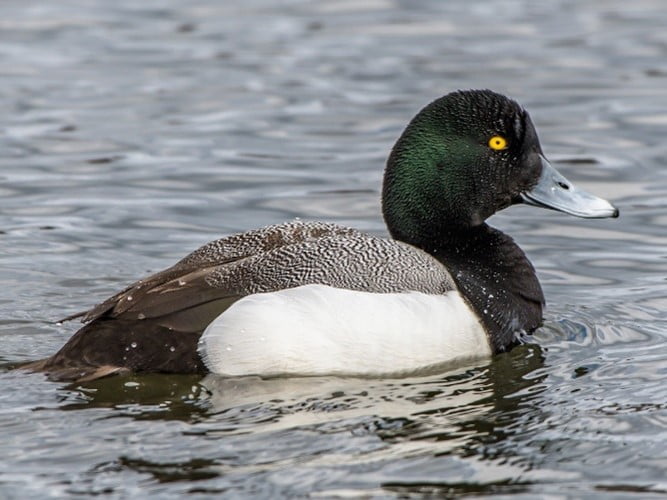
- The Greater Scaup is a medium-sized diving duck species that belongs to the family of Anatidae.
- It is locally known as
- The greater scaup species is distributed in Asia, Europe, United States and Canada.
- It is a rare visitor to the Indian Subcontinent.
- Scientific Name: Aythya marila
- IUCN Red list: Least Concerned
About Loktak Lake

- Loktak Lake is a freshwater lake in the Manipur state of Northeast India.
- It hosts hundreds of floating islands called Phumdis with multiple plant species and Keibul Lamjao National Park, the only floating national park in the world.
- The park is the last natural refuge of the endangered Sangai (state animal).
- The lake is designated as a wetland of international importance under the Ramsar Convention on 23 March 1990.
- It was also listed under the Montreux Record in 1993, “a record of Ramsar sites where changes in ecological character have occurred, are occurring or are likely to occur”.
Source: Indian Express
Previous Year Questions
Q.1) Consider the following pairs:
Wetland/Lake: Location
- Hokera Wetland Punjab
- Renuka Wetland Himachal Pradesh
- Rudrasagar Lake Tripura
- Sasthamkotta Tamil Nadu
How many pairs given above are correctly matched? (2022)
- Only one pair
- Only two pairs
- Only three pairs
- All four pairs
Q.2) Which of the following is not a bird? (2022)
- Golden Mahseer
- Indian Nightjar
- Spoonbill
- White Ibis
Syllabus
- Prelims – International Relations
Context: According to Asian Development Bank (ADB) ’s working paper, the Central Asia Regional Economic Cooperation (CAREC) region faces severe food safety challenges due to fractured safety control systems.
About Central Asia Regional Economic Cooperation:
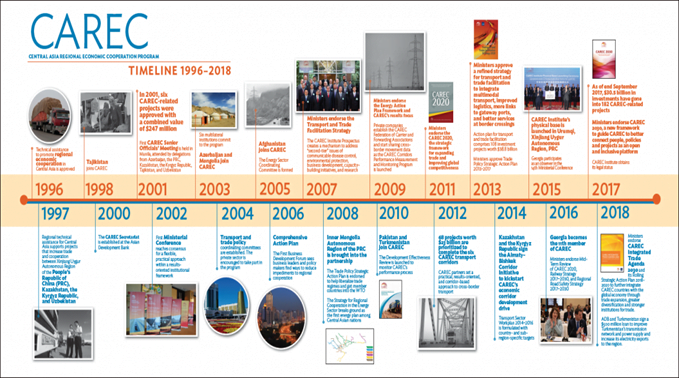
- The Central Asia Regional Economic Cooperation (CAREC) Program is a partnership of 11 countries and development partners working together to promote development through cooperation, leading to accelerated economic growth and poverty reduction.
- It is guided by the overarching vision of “Good Neighbours, Good Partners, and Good Prospects.”
- The program is a proactive facilitator of practical, results-based regional projects, and policy initiatives critical to sustainable economic growth and shared prosperity in the region.
- Since its inception in 2001 and as of December 2021, CAREC has mobilized $41 billion in investments that have helped establish multimodal transportation networks, increased energy trade and security, facilitated free movement of people and freight, and laid the groundwork for economic corridor development.
- CAREC 2030 provides the new long-term strategic framework for the program leading to 2030.
- It is anchored on a broader mission to connect people, policies and projects for shared and sustainable development, serving as the premier economic and social cooperation platform for the region.
- Member countries includes Afghanistan, Azerbaijan, People’s Republic of China, Georgia, Kazakhstan, Kyrgyz Republic, Mongolia, Pakistan, Tajikistan, Turkmenistan and Uzbekistan.
MUST READ: Asian Development Bank
Source: DownToEarth
Syllabus
- Prelims – Science and Technology
Context: The Ministry of Electronics and Information Technology has launched the Technology for Biosensing system for the detection of Endocrine Disrupting Chemicals in aquatic ecosystems (MEAN).
- The Centre for Development of Advanced Computing (C-DAC), Kolkata in collaboration with ICAR-CIFRI, Barrackpore under the ‘National programme on Electronics and ICT applications in Agriculture and Environment (AgriEnIcs)’ has developed the technology.
- The Biosensing based EDC detection system (MEAN), was also transferred to the selected industry Arogyam Medisoft Solution Private Limited for further commercialization of the same technology for deployment at different locations of North-East.
About Endocrine-Disrupting Chemicals (EDCs):

- Endocrine-disrupting chemicals (EDCs) are substances in the environment (air, soil, or water supply), food sources, personal care products, and manufactured products that interfere with the normal function of your body’s endocrine system.
- Since EDCs come from many different sources, people are exposed in several ways, including the air we breathe, the food we eat, and the water we drink. EDCs also can enter the body through the skin.
- EDCs are chemicals or mixtures of chemicals that interfere with the way the body’s hormones work.
- Some EDCs act like “hormone mimics” and trick our body into thinking that they are hormones, while other EDCs block natural hormones from doing their job.
- Other EDCs can increase or decrease the levels of hormones in our blood by affecting how they are made, broken down, or stored in our body.
- EDCs can disrupt many different hormones, which is why they have been linked to numerous adverse human health outcomes including alterations in sperm quality and fertility, abnormalities in sex organs, endometriosis, altered nervous system function etc.
About Centre for Development of Advanced Computing (C-DAC):
- The Centre for Development of Advanced Computing (C-DAC) is an Indian autonomous scientific society, operating under the Ministry of Electronics and Information Technology for carrying out R and D in IT, Electronics and associated areas.
- The setting up of C-DAC in 1988 itself was to build Supercomputers in the context of denial of import of Supercomputers by the USA.
- Since then C-DAC has been undertaking the building of multiple generations of Supercomputer starting from PARAM with 1 GF in 1988.
Source: PIB
Previous Year Questions
Q.1) Consider the following statements in respect of probiotics :
- Probiotics are made of both bacteria and yeast.
- The organisms in probiotics are found in foods we ingest but they do not naturally occur in our gut.
- Probiotics help in the digestion of milk sugars.
Which of the statements given above is/are correct? (2022)
- 1 only
- 2 only
- 1 and 3
- 2 and 3
Q.2) In the context of vaccines manufactured to prevent COVID-19 pandemic, consider the following statements:
- The Serum Institute of India produced COVID-19 vaccine named Covishield using mRNA platform.
- Sputnik V vaccine is manufactured using vector based platform.
- COVAXIN is an inactivated pathogen based vaccine.
Which of the statements given above are correct? (2022)
- 1 and 2 only
- 2 and 3 only
- 1 and 3 only
- 1, 2 and 3
Syllabus
- Prelims – Economy
Context: Recently, The Reserve Bank of India (RBI) published a discussion paper on “loan loss provision”, proposing a framework for adopting an expected loss (EL)-based approach for provisioning by banks in case of loan defaults.
About Loan loss provision:
- The RBI defines a loan loss provision as an expense that banks set aside for defaulted loans.
- Banks set aside a portion of the expected loan repayments from all loans in their portfolio to cover the losses either completely or partially.
- In the event of a loss, instead of taking a loss in its cash flows, the bank can use its loan loss reserves to cover the loss.
- An increase in the balance of reserves is called loan loss provision.
- The level of loan loss provision is determined based on the level expected to protect the safety and soundness of the bank.
- It will enhance the resilience of the banking system in line with globally accepted norms.
- It is likely to result in excess provisions as compared to a shortfall in provisions as seen in the incurred loss approach.
Source: Indian Express
Previous Year Questions
Q.1) With reference to the Indian economy, consider the following statements:
- If the inflation is too high, Reserve Bank of India (RBI) is likely to buy government securities.
- If the rupee is rapidly depreciating, RBI is likely to sell dollars in the market.
- If interest rates in the USA or European Union were to fall, that is likely to induce RBI to buy dollars.
Which of the statements given above are correct? (2022)
- 1 and 2 only
- 2 and 3 only
- 1 and 3 only
- 1, 2 and 3
Syllabus
- Prelims – Geography
In News: A group of Indian researchers found rare cases of fossilised dinosaur eggs — an egg within an egg — among 256 newly discovered eggs from the Narmada Valley.
- The team discovered 92 nesting sites containing 265 fossilised eggs — measuring 15-17 centimetres in diameter — during field investigations in the Dhar district of Madhya Pradesh between 2017 and 2020.
Unique discovery:

- The unique feature of egg within the egg has not been reported from any other dinosaur or even in other reptiles.
- Help to understand the diet and the type of water consumed and the environment in which the eggs were deposited.
- Fossilised eggs provide clues on reproductive biology, nesting behaviour and parental care
About the discovery:
- Titanosaurs — one of the largest dinosaurs to have roamed the Earth — displayed a notable reproductive trait unique to modern-day birds.
- The egg has two yolks; this feature can be seen in birds, suggesting they share similar reproductive traits.
- They nested in colonies, a feature found in about 13 per cent of modern-day birds. They also laid eggs in sequential order like avian species.
- Titanosaurs buried their eggs in shallow pits, a behaviour seen in modern-day crocodiles.
- The eggs belonged to six species, suggesting a higher diversity of these extinct giants in India.
- Parental care was likely absent as the eggs were laid too close to each other. The spacing did not provide room for adults, suggesting that hatchings were forced to fend for themselves
- Dhiman speculates that the “egg-in-egg feature” did not benefit the dinosaurs. The pore canals get blocked due to the presence of two eggshell layers, one above the other. This could asphyxiate the embryo, she added.
- Among the fossils, the team also found unhatched eggs.
- Infertility, embryo death before hatching and deep burial could have contributed to their death. Environmental factors such as floods could also be involved
Location:
- This region falls between the easternmost Lameta exposures at Jabalpur in the upper Narmada Valley (central India) and Balasinor in the west in the lower Narmada Valley (western central India)
- Lameta exposure is a sedimentary rock formation known for its dinosaur fossils.
- These sedimentary rocks are mostly exposed along the Narmada Valley
- The fossil records here are largely concealed by Deccan volcanic flows, which prevents their removal by erosion.
Previous Year Question
Q1) The word ‘Denisovan’ is sometimes mentioned in media in reference to (2017)
- fossils of a kind of dinosaurs
- an early human species
- a cave system found in North-East India
- a geological period in the history of Indian subcontinent
Source: DTE
Syllabus
- Prelims – Environment
In News: New research done in the Dongting lake in China that joins the Yangtze river found the cetaceans were pushed out of certain stretches of their habitat due to sand mining.
- This divides up the population and increases stress among the individuals, especially during pregnancy
- Gaps between porpoises in the lake reached 27 kilometres in 2009
Yangtze finless porpoise:
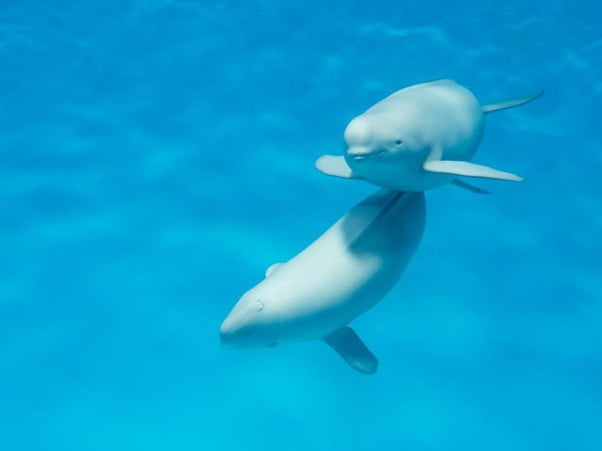
- IUCN status – critically endangered
- The Yangtze finless porpoise belongs to the group of animals which also includes dolphins and whales.
- It is the only freshwater porpoise in the world and breeds just once in 18 months.
- It is the most critically endangered of its taxonomic group and the species has an 86 per cent chance of becoming extinct in the next century.
- Yangtze River dolphin was lost
- The lake is connected to the main body of the Yangtze river by a channel that runs under the Dongting Lake Bridge.
- The porpoise population would swim to and from the river through this channel but because of sand mining, they were not seen in this channel any longer.
Sand Mining:
- Overfishing, increased shipping traffic and noise pollution have all been linked with the decline of the porpoise.
- Sand mining – mining activity posed multiple challenges to this endangered species.
- Sand mining was banned in the region in 2017
- Mining-induced loss of near-shore habitats, a critical foraging and nursery ground for the porpoise, occurred in nearly 70 per cent of the water channels
- Sand mining, which has tripled in the last two decades, is an emerging concern for global biodiversity – Over 50 billion tonnes of sand is mined every year.
- The menace is most rampant in Asia, Africa and Latin America.
- It threatens biodiversity and interferes with ecological processes through “direct physical disturbances, habitat degradation and reducing water quality by altering sedimentation
- Higher urbanisation has made sand the second-most extracted natural resource in the world after water.
- Checking sand mining can help the population of the Yangtze finless porpoise to rebound
Sources: DTE
Previous Year Question
Q1) Which one of the following is the national aquatic animal of India? (2015)
- Saltwater crocodile
- Olive ridley turtle
- Gangetic dolphin
- Gharial
Syllabus
- Prelims – Science and Technology
In News: An Indo-Russian joint venture has started manufacturing Kalashnikov AK-203 assault rifles in Uttar Pradesh’s Amethi, a move that will lend greater firepower to the Indian armed forces.
- Russia and India continue to implement military-technical cooperation projects.
AK 203:

- The AK-200-series assault rifles have retained all the advantages of the traditional AK scheme — reliability, durability and ease of maintenance. At the same time, they fully meet the latest requirements for firearms in the world in terms of ergonomics and the ability to mount high-tech additional equipment
- AK 203 has excellent ergonomics, adaptability to different shooters and high performance characteristics, it is one of the best assault rifles in the world
Manufacturing:
- Today, India is the first country to start producing the AK-200-series assault rifles of the world-famous brand
- Korwa Ordnance Factory in Amethi, Uttar Pradesh, has produced the first batch of 7.62 mm Kalashnikov AK-203 assault rifles.
- Indo-Russian Rifles Private Limited is the manufacturer
- It is a joint venture, registered and located in India, whose founders on the Russian side are Rosoboronexport and Kalashnikov Concern (both subsidiaries of the Rostec State Corporation)
- It fully complies with the government of India’s Made in India initiative and DAP (Defence Acquisition Procedure) 2020.
- Indo-Russian Rifles Private Limited plans to ensure 100 per cent localisation of the production of AK-203 rifles in India.
- Rosoboronexport aims to cooperate on terms of transfer of technology put forward by the Indian side and in accordance with the Make in India initiative
- In future, the company may also increase output and upgrade its production facilities to produce advanced rifles based on the Kalashnikov assault rifle platform.
- High-quality, convenient and modern small arms will begin to enter service with India’s defence and law enforcement agencies
Source: Business standard
Syllabus
- Prelims – Economy
In News: The National Financial Reporting Authority (NFRA) has published the draft requirements on preparation and publication of Annual Transparency Report (ATR) by auditors and audit firms, towards enhancing transparency about management and governance of audit firms and their internal policy framework.
National Financial Reporting Authority (NFRA)
Aim
- Protect the public interest and the interests of investors, creditors and others associated with the companies or bodies corporate governed under Rule 3 by establishing high quality standards of accounting and auditing and exercising effective oversight of accounting functions performed by the companies and bodies corporate and auditing functions performed by auditors.
About:
- NFRA is an independent regulator for the auditing profession under Ministry of Corporate Affairs
- Constituted in 2018 by the Government of India under Sub Section (1) of section 132 of the Companies Act, 2013.
- The authority consists of a chairperson, three full-time members and a secretary and total number of members should not exceed fifteen
- Over 6,800 companies come under NFRA purview, which include listed as well as unlisted companies.
- The NFRA can impose a penalty of not less than ₹1 lakh but not exceeding 5 times the fees collected.
Functions:
- Recommend accounting and auditing policies and standards to be adopted by companies for approval by the Central Government;
- Monitor and enforce compliance with accounting standards and auditing standards;
- Oversee the quality of service of the professions associated with ensuring compliance with such standards and suggest measures for improvement in the quality of service
ATR requirements:
- Objective is to ensure high quality audits and preventing the conflict of interest by maintaining independence.
- The ATR requirements are on the lines of the contemporary international best practices implemented by certain prominent Independent Audit Regulators in other jurisdictions
- Rule 8(2) of the NFRA Rules 2018 empowers the NFRA to require an auditor to report on its governance practices and internal processes designed to promote audit quality, protect its reputation and reduce risks including risk of failure of the auditor and may take such action on the report as may be necessary.
- It contains certain critical information about the auditor’s operational activities, management, governance and ownership structures, and policies and procedures necessary to deliver high-quality audits etc.
- The information contained in the ATR will be useful to the Investors, Audit Committees, Independent Directors and public at large.
- The ATR requirements are proposed to be implemented in a gradual manner for PIEs starting with Statutory Auditors of Top 1000 Listed Companies (by market capitalisation) with effect from the financial year ending on 31 March 2023. The ATR has to be published within three months from the end of each financial year.
Source: Financial Express
Syllabus
- Mains – GS 2 (Governance)
Context: The AatmaNirbharta has evolved as a new model of sustainable development for India as a learning Nation which has unity in diversity.
About Atmanirbharta:
- The meaning of the term ‘Aatmanirbhar Bharat’ is self-reliant India.
- In his speech, the Prime Minister observed that to fulfil the dream of making the 21st century India’s, the way forward is through ensuring that the country becomes self-reliant.
- The aim is to make the country and its citizens independent and self-reliant.
- Five pillars of Aatma Nirbhar Bharat are

- Economy: contemplates not an Incremental change but a quantum leap so that we can convert the current adversity into an advantage.
- Infrastructure: that can be an image of modern India or it can be the identity of India.
- Systems: driven by 21st-century technology, and that is not based on old rules.
- Democracy: a vibrant democracy that is the source of energy to make India self-reliant.
- Demand: where the strength of our demand and supply chain is utilized intelligently.
Significance of Aatmanirbhar Bharat Abhiyan
- Self-reliance will make globalization human-centric.
- The definition of self-reliance has changed in a globalized world and it is different from being self-centred.
- India’s fundamental thinking and tradition of “Vasudhaiva Kutumbakam” provides a ray of hope to the world.
- This should be seen in the context of Human-Centric Globalization versus Economy Centralized Globalization.
- Self-reliance does not mean cutting India off from the world.
- India believes in the welfare of the world and India’s progress is linked with the world.
- The world trusts that India has a lot to contribute to the development of the entire humanity.
Challenges associated with current trends in development:
- The economy is already struggling with a low number of jobs and the job situation in the country is poised to face severe damage due to the pandemic.
- India’s low state capacity, poor healthcare infrastructure, and highly populated urban centres have left it particularly affected by the pandemic, which has weighed further on the economy.
- If the government does not undertake the opening of various sectors to private enterprises, ease overbearing regulation, and privatise loss-making PSUs, India’s manufacturing sector will become further uncompetitive.
- This would make future governments averse to opening up the economy again.
- Schemes like more protectionist trade stance and any increase in tariff rates for imports may lead to punitive tariffs or the revocation of trade benefits from its partners.
- Insufficient support for the state governments – the state governments which are at the forefront of fighting the pandemic have not been supported adequately via fund transfers.
Suggestive measures:
- This is a time when the legitimate aspirations of the diverse peoples of our country need to be reconciled self-reliant India working for Vasudaiva Kutumbakam.
- Atmanirbharta should be seen as a means for regaining India’s share in the global economy while simultaneously improving the quality of life for the common Indian.
- It will require a huge concerted effort from all stakeholders to restore India’s share in global trade to pre-colonial levels.
- Achieving global scales of production, improving the quality of our services to world standards and promoting goal-oriented R and D are efforts that will yield the desired goal of a higher share in global trade and manufacturing.
- No nation can progress without engaging its citizens in the development process. Citizenship is not just about participating in the electoral process.
- It is also about enlightening oneself with information, engaging with the state and its agencies and operating with a sense of empowerment.
- India has performed well in producing new knowledge, the focus should be now on harnessing this knowledge for economic growth.
Source: Indian Express
Syllabus
- Mains –GS 2 Polity and Governance
Context:
- The Election Commission of India (ECI) could not demonstrate a prototype of its new Remote Electronic Voting Machine (RVM), which would allow domestic migrants to vote in national and regional elections.
- EVMs started being used on a larger scale in 1992 and since 2000, have been used in all Lok Sabha and State Assembly elections.
About Remote Voting Machines:
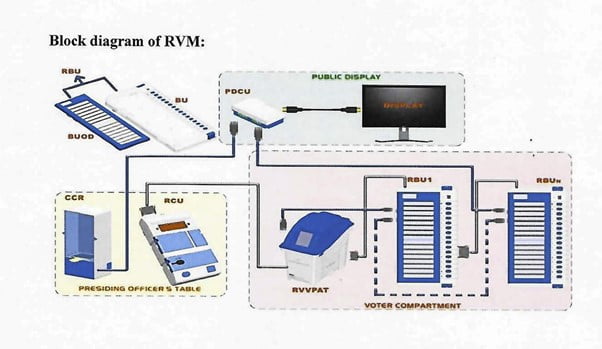
- The Multi-Constituency RVM for migrant voting will have the same security system and voting experience as the EVM.
- RVM can handle multiple constituencies (up to 72) from a single remote polling booth.
- For this, instead of a fixed ballot paper sheet, the machine has been modified to have an electronic dynamic ballot display which will present different candidate lists corresponding to the constituency number of the voter read by a constituency card reader.
- The ECI has added a digital public display unit or a monitor to act as an interface between the constituency card reader and the BU display.
- the electronic ballot will be prepared by the Returning Officers (ROs) of home constituencies of voters, and forwarded to the remote RO for uploading in the SLU.
Concerns of RVM:
- Lack of clarity on how these new devices communicate with each other, Whether it is a device with programmable memory
- Question on integrity – would it be possible to mess with the digital display to show a modified list to the voter, since the unit is connected to an external device for symbol loading
- Logistical and administrative challenges – including voter registration in remote locations, how names will be removed from the electoral rolls of the home constituency, how remote voting applications will be made transparent etc.
- Further, the challenges regarding the current EVMs will persist when it comes to the RVMs.
How do existing EVMs work?
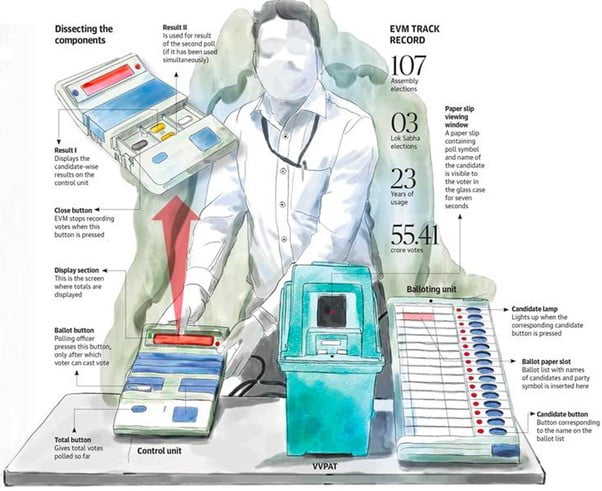
- The latest EVM is an M3 model which was manufactured from 2013 onwards.
- It has a Balloting Unit (BU) which is connected to the VVPAT printer, both of which are inside the voting compartment.
- The VVPAT is connected to the Control Unit (CU), which sits with the Presiding Officer (PO) and totals the number of votes cast, on its display board.
- Only once the PO presses the ballot button on the CU, does the BU get enabled for the voter to cast her vote by pressing the key corresponding to the candidate on the ballot paper sheet pasted on the BU.
- The VVPAT, which is essentially a printing machine, prints a slip with the poll symbol and candidate name, once the voter presses the key on the BU.
- This slip is visible to the voter on the VVPAT’s glass screen for seven seconds after which it gets dropped off in a box inside the VVPAT.
- Once a vote is cast, the BU becomes inactive till the PO schedules the next vote by enabling it again from the CU
Voter Verified Paper Trail Audit (VVPAT)
- Developed by ECI along with two Public Sector Undertakings (PSU), in 2010
- It is a mechanism that could help verify that the EVM had recorded the vote correctly as intended by the voter
- The use of VVPATs has become universal in elections since mid-2017.
- To create a VVPAT sheet on the laptop, an application is either downloaded from the ECI server or copied from a local device.
- It is then uploaded to another device or the Symbol Loading Unit (SLU) through a nine-pin cable, which in turn is connected to the VVPAT for upload. This process raises questions.
Significance of Indian EVMs
- They are standalone, are not connected to the internet, and have a one-time programmable chip, making tampering through the hardware port or through a Wi-Fi connection impossible.
- As per ECI, EVMs are “robust, secure, and tamper-proof”, owing to the technical and institutional safeguards in place.
- Such as the sealing of machines with signatures of polling agents, first-level checks, randomisation of machines, and a series of mock polls before the actual voting, cannot be circumvented.
Concerns about EVMs:
- A 2021 report titled, ‘Is the Indian EVM and VVPAT System Fit for Democratic Elections?’ highlighted the widely recognised ‘democracy principles’ to be adhered to while conducting public elections.
- Lack of transparency – Details of the EVM design, prototype, software, and hardware verification are not publicly available for technical and independent review, rendering it available only for a black-box analysis, where information about its inner workings is not accessible.
- EVM tampering – claim that EVM tampering through a WIFI connection is not possible has been disrepute by multiple computer scientists as it does not take into account ‘side-channel’, insider fraud, and trojan attacks.
- Besides, the OTP chip which cannot be rewritten, also has a flip side
- Outsourcing – The ECI sends the EVM software to two foreign chipmakers (in the U.S. and Japan) to burn into the CPU and the manufactured chips are then sent to India for assembly into machines by the two PSUs (BEL and ECIL).
- This means that the manufacturers cannot read back the contents of the software to ensure its integrity is intact.
- Functionality tests done by manufacturers can only reveal if the machine is working properly.
- Hacking – A fixed number of votes are casted at the beginning of the polls in each polling station. Thus, a hack can easily bypass the first few votes, thereby preventing detection of foul play as every key press in the EVM is date and time stamped”.
Concerns with VVPAT:
- EVM Tampering – Even if the voting machine is tampered, the same should be detectable in an audit.
- Machine dependence – For the voting process to be verifiable and correct, it should be machine-independent, or software and hardware independent, meaning, the establishment of its veracity should not depend solely on the assumption that the EVM is correct.
- Voter verification – The current VVPAT system is not voter verified in its full sense, meaning, while the voter sees their vote slip behind the VVPAT’s glass for seven seconds, it does not mean they have verified it.
- Vote cancellation – That would happen if the voter got the printout in their hand, was able to approve it before the vote is finally cast, and was able to cancel if there is an error.
- Former IAS officer Kannan Gopinathan, notes “voter should have full agency to cancel a vote if not satisfied; and that the process to cancel must be simple and should not require the voter to interact with anybody
- Voter penalisation is discouraging – Under the current system, if the voter disputes what they have seen behind the screen, they are allowed a test vote in the presence of an election officer, and if the outcome of the test vote is correct, the voter can be penalised or even prosecuted
- Questionable Assurance – by ECI that the EVM-VVPAT system is not connected to any external device has been questioned by former civil servants.
- Since, for the VVPAT to be able to generate voting slips, the symbols, names and the sequence of the candidates need to be uploaded on it which is done by connecting it to a laptop.
- Opacity regarding communication protocol – If the VVPAT is cleared and loaded with new information for every election, does this mean it has a programmable memory? These questions remain unaddressed.
Way forward
- Ronald Rivest, an MIT professor and the inventor of encryption, defined that “a voting system is software (hardware) independent if an undetected change in software (hardware) cannot lead to an undetectable change in the election outcome”
- Elections should uphold the democratic principles – The election process should not only be free and fair but “also be seen to be free and fair”, meaning instead of being told to trust the process the general public should be provided with provable guarantees to facilitate this trust.
Source: The Hindu
Baba’s Explainer – Doppler Weather Radar
Syllabus
- GS-3: Science and Technology- developments and their applications and effects in everyday life.
Context: Union Minister of State Science & Technology; Minister of State Earth Sciences; MoS PMO, Personnel, Public Grievances, Pensions, Atomic Energy and Space said, Entire Country will be covered by Doppler Weather Radar Network by 2025
- According to the Annual Statement on Climate of India 2022 issued by the India Meteorological Department (IMD), 2,227 extreme weather-related deaths in India.
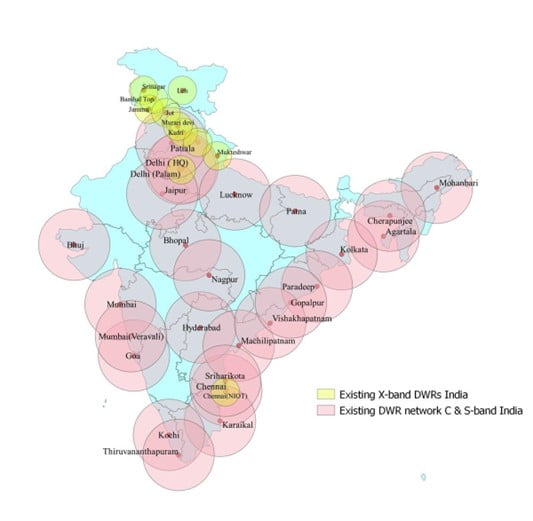
Read Complete Details on Doppler Weather Radar
Practice MCQs
Q.1) With reference to ‘Titanosaurs’, consider the following statements
- They resemble reproductive traits of crocodiles
- Their fossilised eggs have been discovered in India.
Which of the following statements are correct?
- 1 only
- 2 only
- Both 1 and 2
- Neither 1 nor 2
Q.2) With reference to ‘National Financial Reporting Authority’, consider the following statements
- It comes under Ministry of Finance.
- It is responsible for compliance of auditing standards.
- It was established in 2015.
Which of the following statements are correct?
- 1 only
- 2 only
- 1 and 3 only
- 1, 2 and 3
Q.3) The Keibul Lamjao National Park, the only floating national park in the world is in
- Meghalaya
- Manipur
- Assam
- Odisha
Comment the answers to the above questions in the comment section below!!
ANSWERS FOR ’ 19th January 2023 – Daily Practice MCQs’ will be updated along with tomorrow’s Daily Current Affairs.st
ANSWERS FOR 18th January- Daily Practice MCQs
Q.1) – d
Q.2) – a
Q.3) – b













